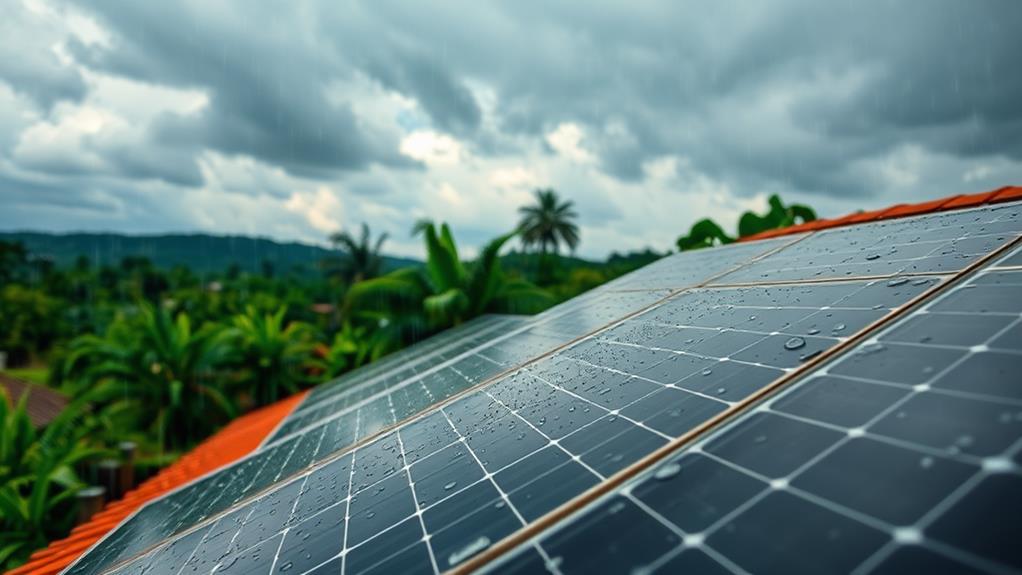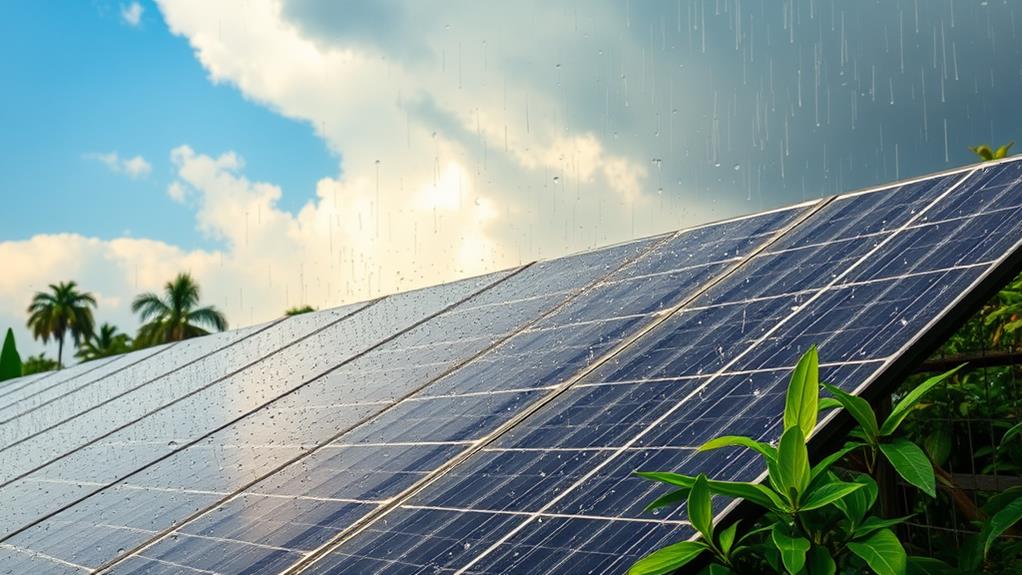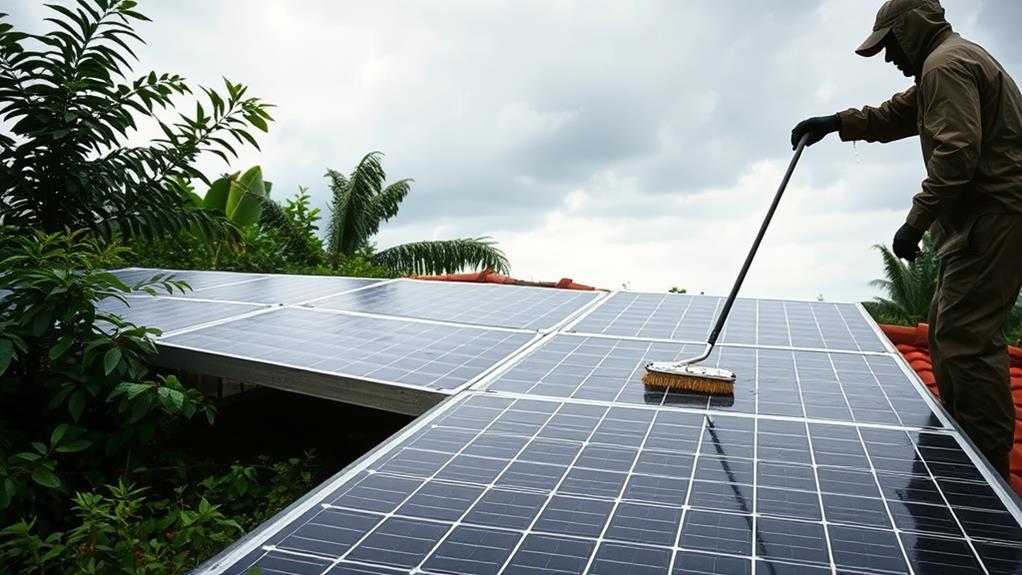Imagine the resilience of a marathon runner; modern solar panels in Kenya exhibit similar endurance, especially when faced with rain. You might wonder if the frequent downpours harm these energy systems, but the reality may surprise you. Rain doesn't just fail to damage solar panels; it actually plays a significant role in maintaining their efficiency. With durable materials and innovative design, these panels withstand the rainy season while benefiting from natural cleaning. Curious about how this works and what other misconceptions might exist? Let's explore the truths and myths surrounding rain and solar panel performance in Kenya.
Understanding Solar Panel Durability

Given the increasing adoption of solar energy in Kenya, understanding solar panel durability is vital. When choosing solar panels, you need to take into account the materials used in their construction and their ability to withstand various weather conditions. High-quality panel materials, such as tempered glass, silicon, and durable aluminum frames, offer excellent weather resilience.
These materials are specifically designed to endure Kenya's diverse climate, including high temperatures, heavy rains, and strong winds. Additionally, high-quality batteries can complement solar panel systems to guarantee a consistent power supply during low generation periods.
Analytical studies have shown that panels made from these robust materials maintain high efficiency over longer periods. For instance, tempered glass is resistant to impacts and scratches, while silicon cells are encapsulated to prevent moisture ingress.
Additionally, aluminum frames not only provide structural integrity but also resist corrosion, which is significant in humid environments.
It's important to recognize that not all solar panels are created equal. Investing in panels with superior materials guarantees they can withstand the dynamic weather patterns in Kenya.
Rigorous testing and certifications, such as IEC 61215, confirm that these panels meet stringent durability standards. By understanding the importance of panel materials and weather resilience, you can make informed decisions that align with your desire for sustainable and reliable energy solutions.
Rain's Impact on Solar Efficiency
You should consider how rain impacts solar efficiency through its cleaning effect, which can remove dust and debris, improving performance temporarily.
This natural cleaning can be especially beneficial in regions with high dust accumulation.
However, frequent rainfall can reduce solar panel output by blocking sunlight, and prolonged exposure to moisture may compromise long-term material durability.
These factors collectively affect the overall efficiency and lifespan of solar panels in Kenya.
For more information on the components and benefits of solar power, you can explore diverse applications of solar energy.
Cleaning Effect of Rain
Rainfall can act as a natural cleaning agent for solar panels, potentially enhancing their efficiency by washing away accumulated dust and debris.
In Kenya, where dust and particulate matter can frequently settle on solar panels, the cleaning effect of rain can be particularly beneficial. By keeping your panels clean, rainwater can contribute to maintaining peak solar panel performance without the need for extensive manual cleaning.
To maximize the benefits of rainwater for solar panel maintenance, consider the following:
- Rainwater Collection: Utilize rainwater collection systems to direct runoff away from panels, guaranteeing that the cleaning process is efficient and minimizes the risk of water pooling.
- Panel Tilt and Orientation: Confirm panels are installed at an angle that promotes effective water runoff, allowing rain to wash away dirt without leaving residues.
- Regular Inspections: Periodically inspect your solar panels after heavy rain to verify that they remain clean and free from stubborn debris.
- Supplemental Cleaning: In areas with infrequent rainfall or excessive dust, supplement rain cleaning with occasional manual or automated cleaning systems.
Reduced Solar Panel Output
Heavy rain can sometimes act as a double-edged sword for solar panels in Kenya. While it helps clean the panels, it also reduces solar energy production. During the rainy season, persistent cloud cover and precipitation decrease the amount of sunlight hitting the panels, thereby affecting panel efficiency and overall energy output.
Weather effects like rain can lead to a temporary dip in energy production. To mitigate this, you should incorporate performance monitoring into your maintenance practices. This allows you to track real-time data and identify any significant drops in efficiency.
Installation considerations are essential to optimize solar panel performance during adverse weather. Guaranteeing proper tilt and orientation can help maximize sunlight capture, even when conditions aren't ideal. Additionally, regular inspections can identify and address issues such as water pooling or debris accumulation, which can further impact efficiency.
In terms of environmental impact, while rain reduces immediate energy output, it can prolong system longevity by naturally cleaning the panels, reducing the need for abrasive manual cleaning methods.
Long-term Material Durability
Over time, exposure to rain can profoundly impact the long-term durability of solar panels, directly influencing their efficiency.
You need to take into account how rainwater, particularly in regions like Kenya, can affect the material resilience and weather resistance of your solar panels. The constant exposure to water and varying temperatures can lead to several long-term issues:
- Corrosion: Persistent moisture can corrode metal components, weakening the structure and leading to efficiency losses.
- Sealant Degradation: The sealants used to protect internal components can break down over time, allowing water ingress and causing electrical failures.
- Micro-cracking: Thermal cycling from wet to dry conditions can cause micro-cracks in the photovoltaic cells, reducing their ability to generate electricity.
- Dirt Accumulation: Rain can carry dirt and debris onto the panel surface, which can accumulate and block sunlight, further diminishing output.
Common Myths About Rain Damage

You might think that rain causes significant corrosion to solar panels, but modern designs use materials that resist water damage. Technologies enhancing efficiency in energy conversion also contribute to their durability.
Another misconception is that rainwater can't effectively clean solar panels, yet studies show it often removes dust and debris. By addressing these myths, you'll better understand how rain actually impacts solar panel maintenance and longevity.
Rain Corrosion Concerns
Among the various concerns about rain damage to solar panels, rain corrosion often tops the list of misconceptions. You might worry that rainwater effects could degrade your solar panels over time, but let's debunk this myth with an analytical approach.
First, modern solar panels are meticulously engineered to withstand environmental elements, including rain. Here's why corrosion isn't the issue you might think it is:
- Materials Used: Panels use corrosion-resistant materials like tempered glass and aluminum frames, providing a robust defense against rainwater effects.
- Protective Coatings: Manufacturers apply anti-corrosion coatings to both the glass and metal parts, greatly enhancing corrosion prevention.
- Sealed Edges: The edges are sealed meticulously to prevent any water ingress that could lead to corrosion within the panel.
- Drainage Design: Panels are designed with integrated drainage systems to guarantee water doesn't accumulate and cause potential damage.
Evidence-based studies have shown that these design elements effectively mitigate corrosion risks, allowing you to harness solar energy without worrying about rain damage.
Cleaning Benefits Misunderstood
While rain corrosion remains a largely debunked worry, another common myth surrounds the cleaning benefits of rain for solar panels. Many believe that rainwater is sufficient to clean solar panels, but this assumption could undermine your system's solar efficiency.
Rain can wash away some surface dust, but it's ineffective against stubborn grime, bird droppings, and industrial residues that accumulate over time. You need to understand proper cleaning techniques to maintain peak performance.
Evidence from various studies shows that dirty panels can lose up to 20% of their efficiency. This data underscores the importance of regular, manual cleaning. Methods like using deionized water and soft brushes can help remove persistent debris without damaging the panels.
Relying solely on rain not only leaves panels inadequately cleaned but also wastes potential energy output. Regular maintenance guarantees your investment yields maximum returns.
Don't let the myth of rain-cleaning fool you into neglecting proper care.
Benefits of Rain for Solar Panels
Rain, often seen as a potential threat to solar panels, actually offers several benefits that can enhance their performance and longevity. When you think about solar panel performance, rain plays an integral role in maintaining and even improving the efficiency of your solar energy system.
For instance, rain contributes to the natural cleaning of the panels, washing away dust, bird droppings, and other debris that accumulate on the panels. This natural cleaning process guarantees that the panels remain clear and can absorb maximum sunlight.
Additionally, rain helps in temperature regulation by cooling the panels and preventing overheating. Solar panels operate more efficiently at lower temperatures; consequently, rain indirectly boosts their performance. This cooling effect is essential because solar irradiance and performance efficiency are greatly influenced by weather conditions.
Another advantage is rainwater harvesting. If you have a rainwater harvesting system in place, the runoff from your solar panels can be collected and reused. This is a sustainable practice that aligns well with the eco-friendly goals of solar energy enthusiasts.
Lastly, by keeping the panels clean and cool, rain contributes to reducing wear and tear. This can extend the operational lifespan of your solar panels, giving you more value for your investment.
Maintenance Tips During Rainy Seasons

Even though rain offers multiple benefits for solar panels, it's important to adopt effective maintenance strategies during rainy seasons to guarantee peak performance and longevity.
First, regularly inspect the panels for any debris or water pooling, as these can obstruct sunlight and reduce efficiency. Cleaning the panels with a soft cloth and mild detergent can prevent long-term grime buildup, enhancing their ability to absorb sunlight. For those using off-grid solutions, ensuring the components for battery charging are also well-maintained is essential.
Implement preventative measures by checking the mounting structures and ensuring they're securely fastened. Loose mounts can lead to misalignment or damage during heavy rain and strong winds. Additionally, apply anti-corrosive coatings on exposed metal parts to protect against rust.
Seasonal adjustments are vital. During the rainy season, monitor the energy output more frequently. If you notice a significant drop, it might indicate underlying issues that need immediate attention. Installing a monitoring system can automate this process and alert you to any anomalies.
Lastly, consider trimming nearby trees that could drop leaves or cause shade. This proactive approach minimizes debris and maximizes sunlight exposure.
Ensuring Long-term Solar Performance
For achieving long-term solar performance, it's vital to implement a thorough maintenance plan that addresses both immediate and future challenges.
To guarantee your solar energy system maintains its efficiency and operational longevity, consider the following strategies:
- Regular Performance Monitoring: Keep a close eye on energy yield and system performance. Regularly check for drops in efficiency that might indicate underlying issues.
- Weather-Responsive Maintenance: Adapt your maintenance strategies to seasonal weather conditions. In Kenya, heavy rains can affect panel cleanliness and mounting stability. Confirm that your panels are clean and securely anchored.
- Installation Considerations: Proper installation is fundamental. Verify that panels are installed at ideal angles to maximize sunlight exposure and are resilient against environmental factors like wind and rain.
- Climate Resilience: Invest in high-quality, weather-resistant materials. Panels and mounting systems designed for climate resilience can withstand extreme weather, assuring longevity.
Conclusion
You've seen that rain doesn't damage solar panels in Kenya; it actually enhances efficiency. Durable designs and corrosion-resistant materials guarantee longevity. Rain washes away dust, boosting sunlight absorption. Don't let myths mislead you; rain's role is vital. Regular maintenance during rainy seasons is fundamental for peak performance. With this all-encompassing understanding, you can confidently capitalize on Kenya's climatic conditions and secure long-term solar success. Embrace the evidence, and enjoy the efficiency!
